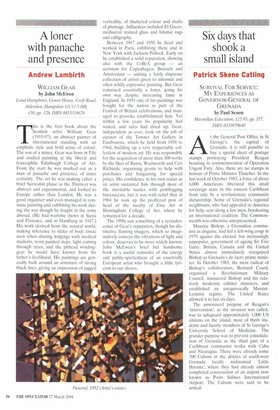A loner with panache and presence
Andrew Lambirth
WILLIAM GEAR by John McEwen Lund Humphries, Gower House, Croft Road, Aldershot, Hampshire GUI] 3 HR, £30, pp. 128, ISBN 0853318670 This is the first book about the Scottish artist William Gear (1915-97), an abstract painter of international standing with an emphatic style and bold sense of colour. The son of a miner, Gear was born in Fife and studied painting at the liberal and francophile Edinburgh College of Art. From the start he was marked out as a man of panache and presence, of inner certainty. The art he was making (after a brief Surrealist phase in the Thirties) was abstract and experimental, and looked to Europe rather than London. He was a good organiser and even managed to continue painting and exhibiting his work during the war though he fought in the army abroad. (He had wartime shows in Siena and Florence, and in Hamburg in 1947.) His work derived from the natural world, making reference to slides of body tissue seen when sharing lodgings with medical students, worn painted steps, light coming through trees, and the pithead windinggear he would have known from his father's livelihood, His paintings are generally built around an armature of strong black lines, giving an impression of jagged
verticality, of shuttered colour and shafts of plumage. Influences included El Greco, mediaeval stained glass and Islamic rugs and calligraphy.
Between 1947 and 1950 he lived and worked in Paris, exhibiting there and in New York with Jackson Pollock. Early on he established a solid reputation, showing also with the CoBrA group — an acronym for Copenhagen, Brussels and Amsterdam — uniting a fairly disparate collection of artists given to informal and often wildly expressive painting. But Gear remained essentially a loner, going his own way despite increasing fame in England. In 1951 one of his paintings was bought for the nation as part of the Festival of Britain celebrations, and managed to provoke establishment fury. Yet within a few years his popularity had waned, and sales had dried up. Gear, independent as ever, took on the job of curator of the Towner Art Gallery in Eastbourne, which he held from 1958 to 1964, building up a very respectable collection of modern art. He was responsible for the acquisition of more than 300 works by the likes of Burra, Wadsworth and Ceri Richards, organising grants to help with purchases and bargaining for special prices. His confidence in his own status as an artist sustained him through most of the inevitable tussles with pettifogging bureaucrats, but it was with relief that in 1964 he took up the proffered post of head of the faculty of Fine Art at Birmingham College of Art, where he remained for a decade.
The 1990s saw something of a recrudescence of Gear's reputation, though his distinctive flaming imagery, which so imaginatively conveys the vibrations of light and colour, deserves to be more widely known. John McEwerfs brief but handsome book is a useful reminder of the energy and public-spiritedness of an essentially European artist who brought a little lyricism to our shores.


























































































 Previous page
Previous page